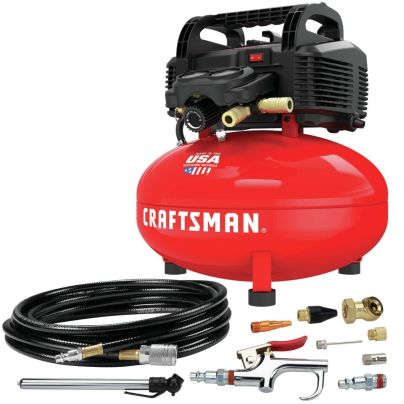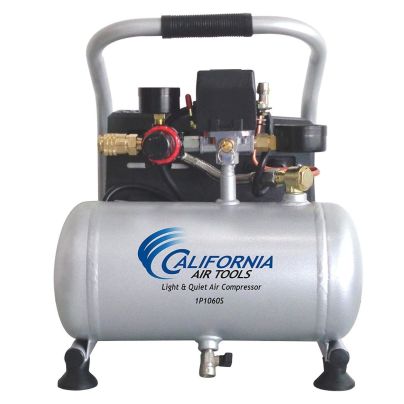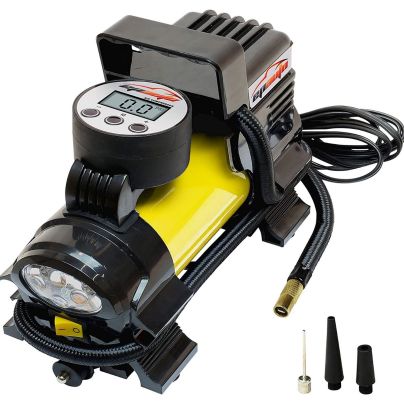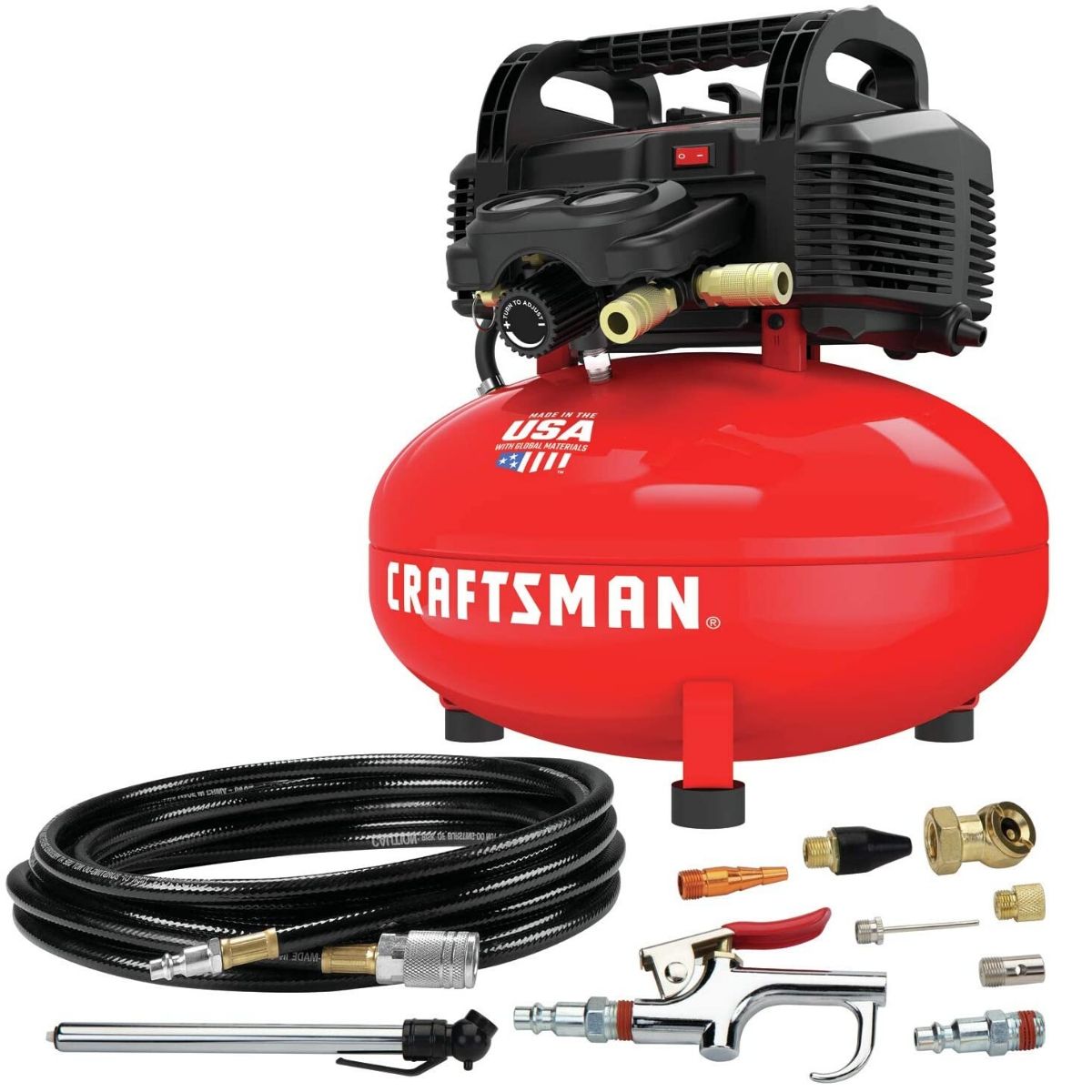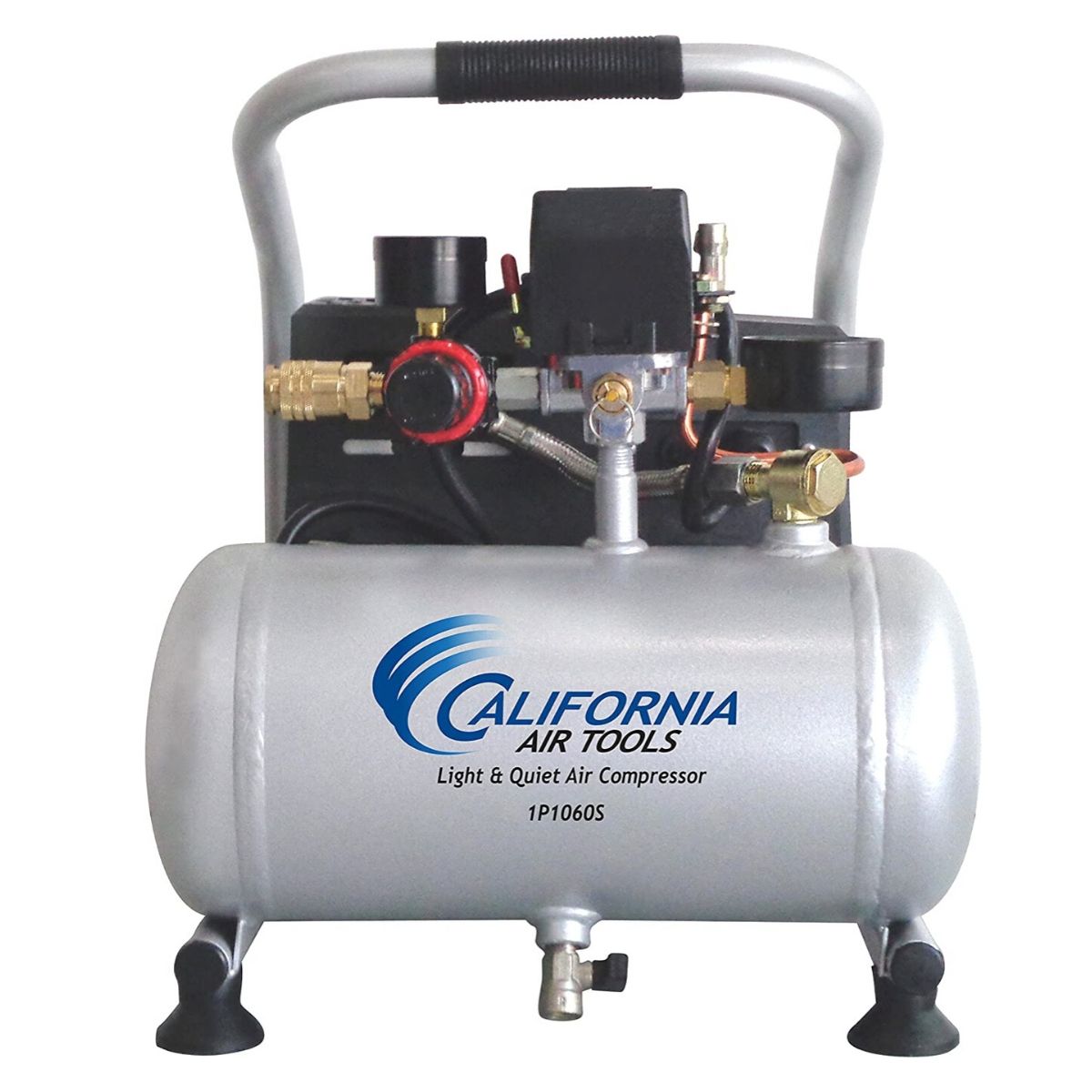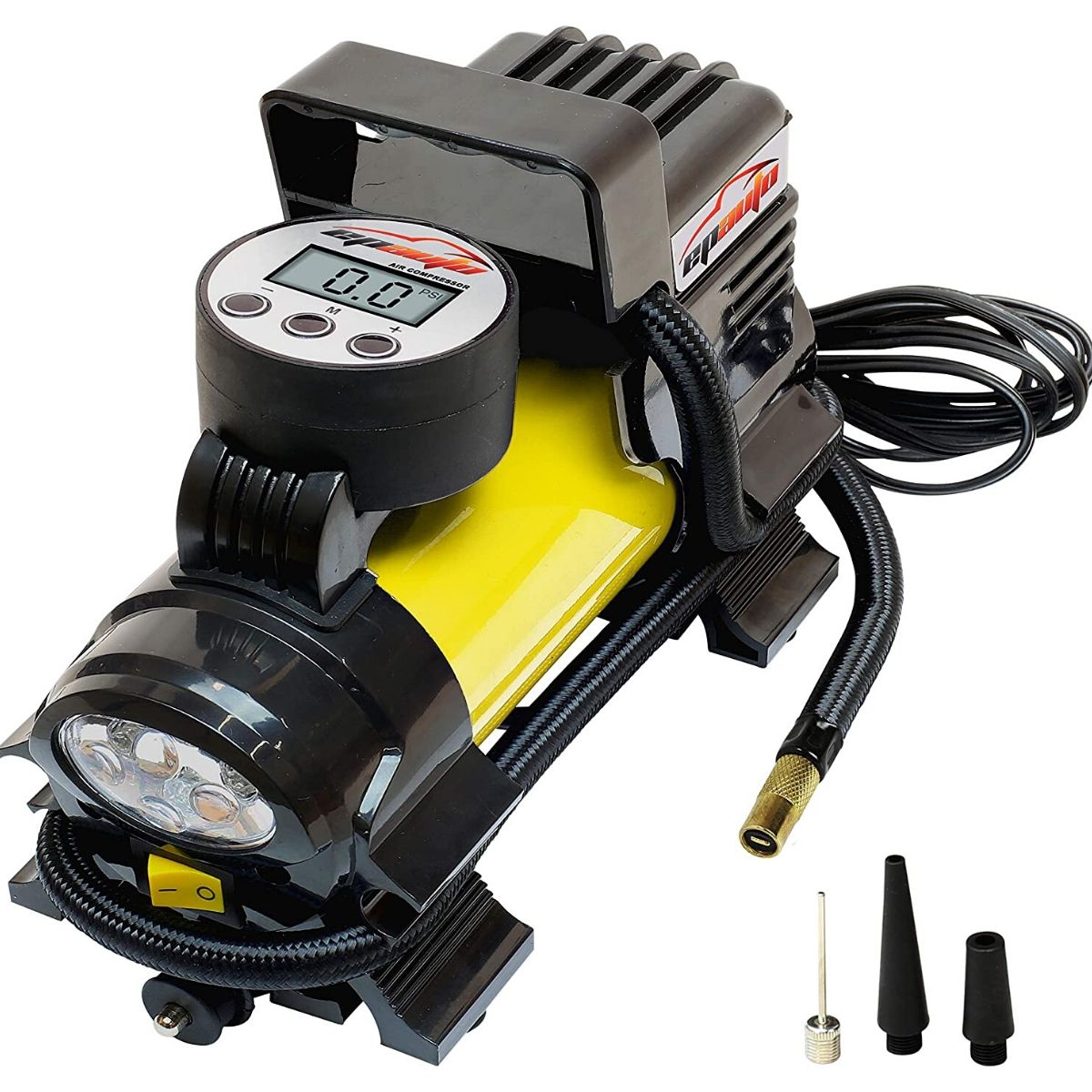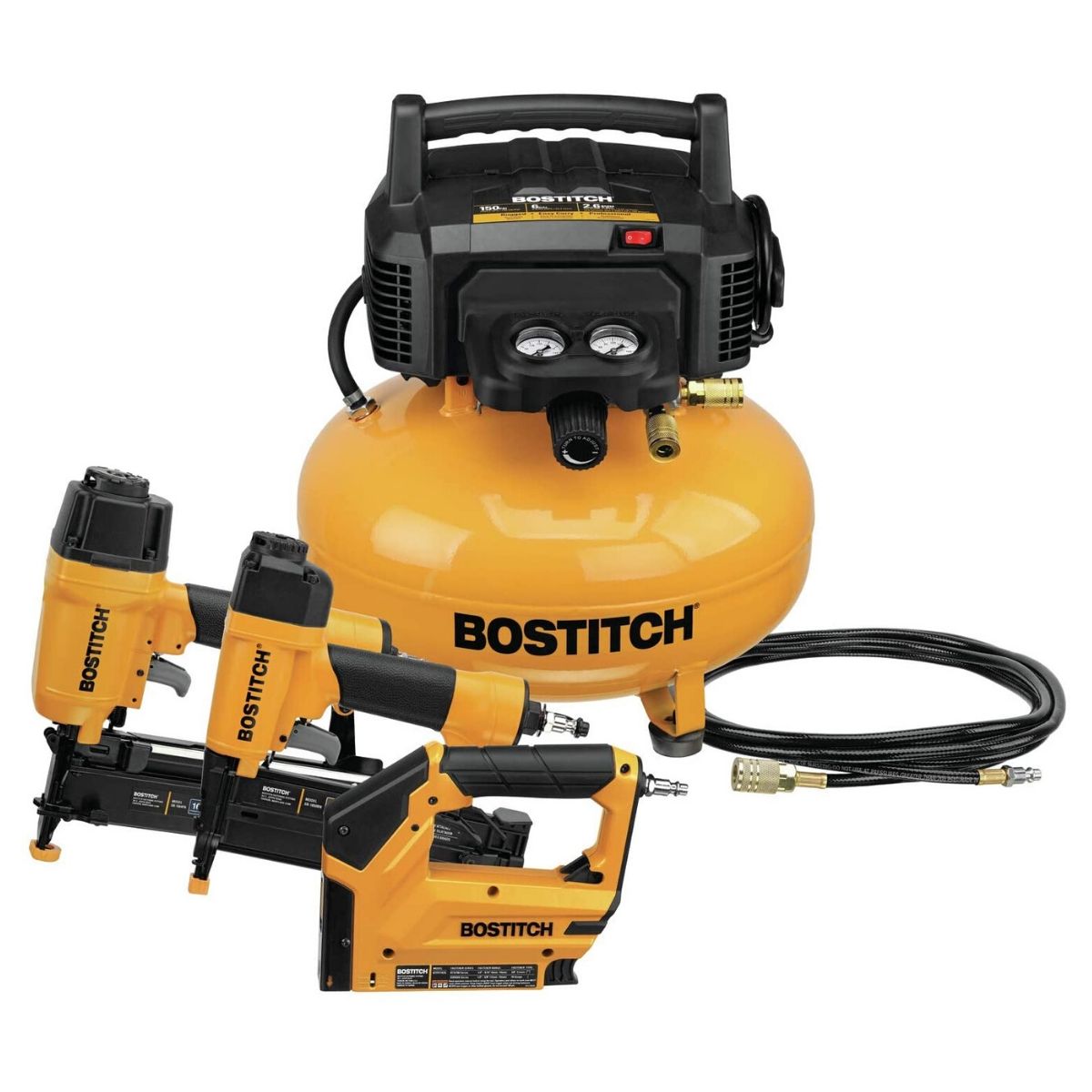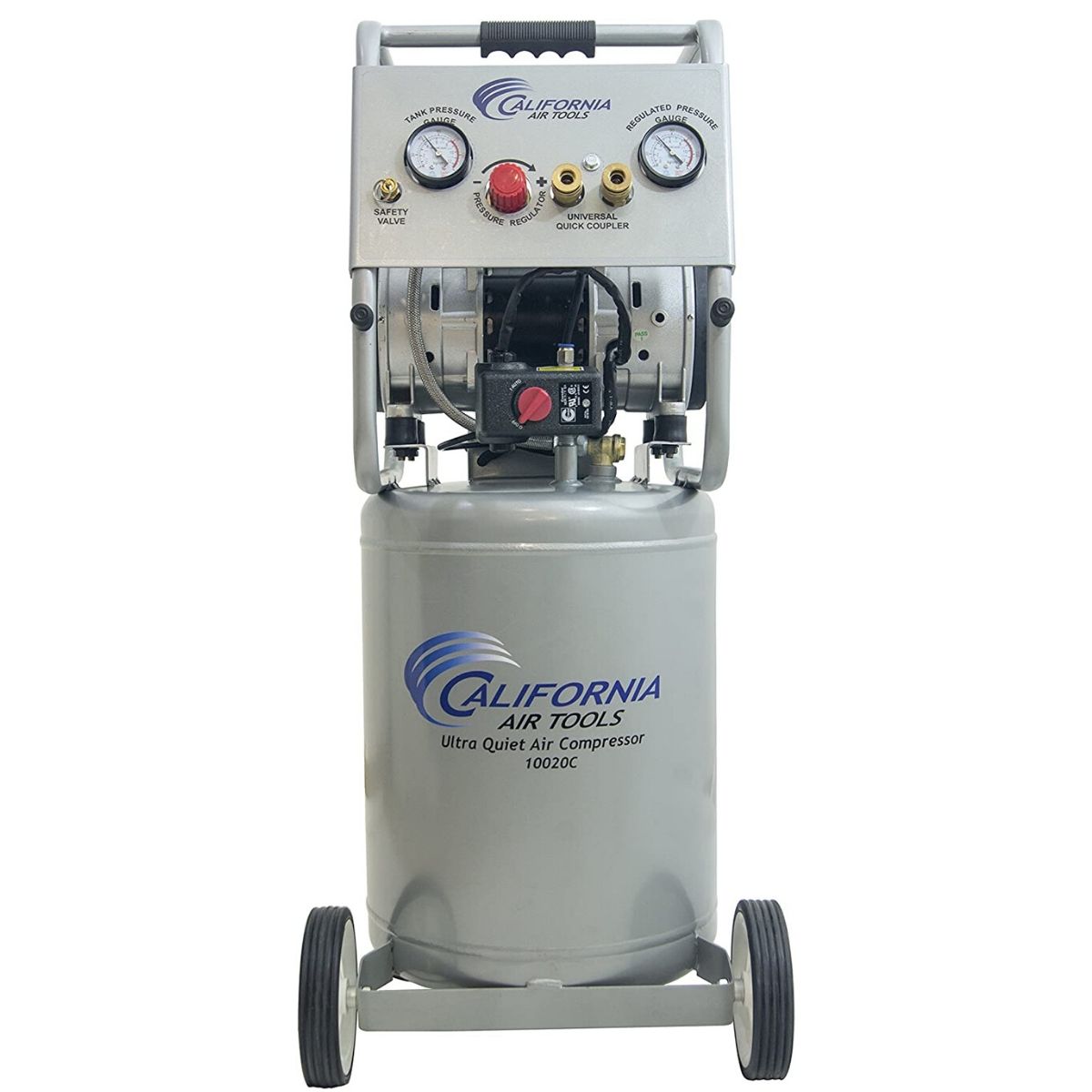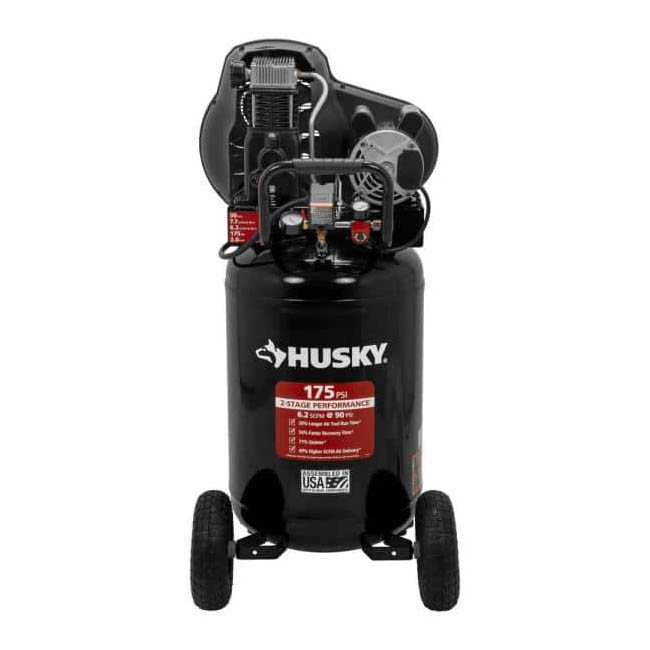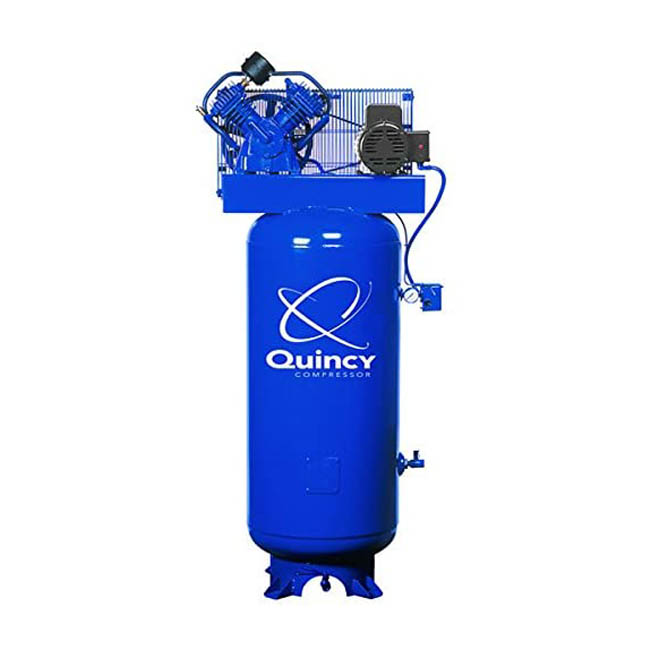We may earn revenue from the products available on this page and participate in affiliate programs. Learn More ›
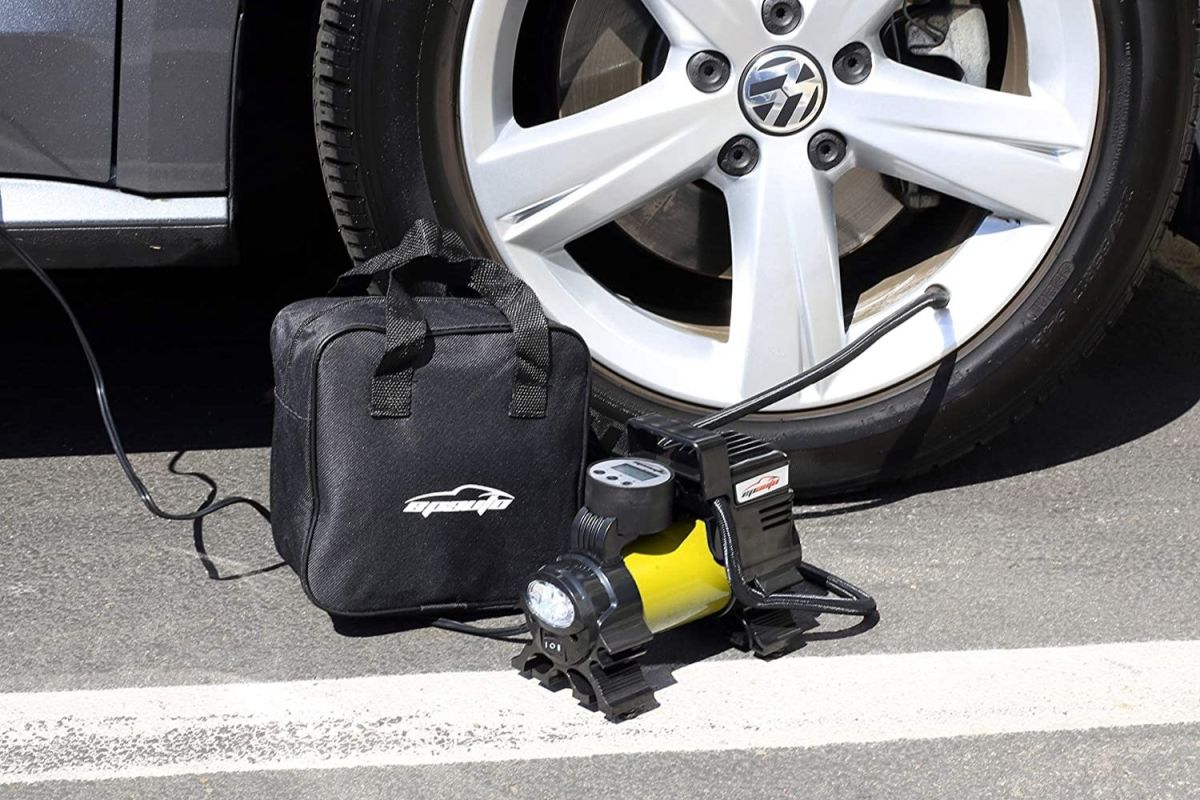
An air compressor pulls air from the surrounding environment and jams it into its storage tank. It stores the air under pressure until it’s released through a pneumatic tool—like a nail gun or paint sprayer—in powerful bursts or a steady stream.
Air compressors can range from small, portable models—great for inflating sports equipment, bike tires, or car tires—to large 60-gallon tanks for continuous air pressure for spray-painting projects. For the best home air compressor for large projects, check out our top picks in their respective categories.
- BEST OVERALL: CRAFTSMAN Air Compressor, 6 gallon
- BEST BANG FOR THE BUCK: California Air Tools 1P1060S Portable Air Compressor
- BEST FOR INFLATING: EPAuto 12V DC Portable Air Compressor Pump
- BEST FOR FASTENING: BOSTITCH Air Compressor Combo Kit
- BEST FOR SPRAY PAINTING: California Air Tools 10020C Quiet Air Compressor
- BEST FOR AUTO WORK: Husky 30 Gal. 175 PSI Oil Lubed Belt Drive Portable
- BEST FOR LARGE PROJECTS: Quincy QT-54 Splash Lubricated Air Compressor
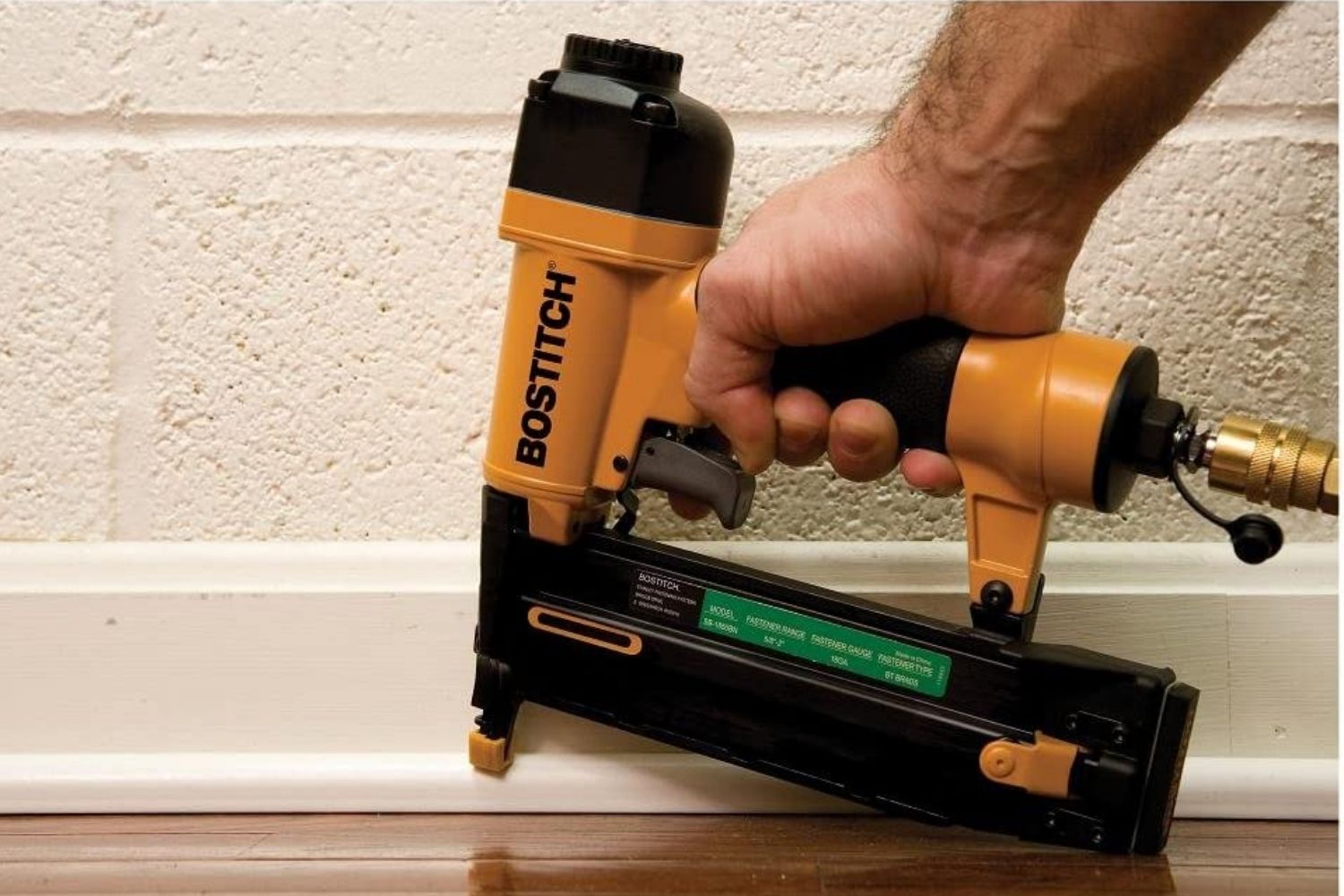
What to Look for When Choosing a Home Air Compressor
Before you buy a new air compressor, take a few minutes to learn about the essential features to consider and how a project or usage determines the type of air compressor that might best fit the job.
Gas vs. Electric
There are two main types of air compressors: gas and electric.
- Gas-powered air compressors, larger than their electric-powered counterparts, produce a higher horsepower (HP), more pounds per square inch (PSI), and more cubic feet per minute (CFM) than electric ones. While their bigger size makes them difficult to transport without wheels, gas-powered air compressors won’t tether users to an electrical outlet either, which provides a level of mobility that not all electric compressors can.
- Electric-powered air compressors plug into an outlet or run on battery power. They make for a smaller and much more mobile option, provided that an electrical source, like an outlet or generator, is available. Significantly quieter than gas-powered air compressors, electric air compressors also put out significantly less power. Fortunately, most electric air compressors meet the HP, PSI, and CFM required for DIY tasks, such as fastening trim using a finish nailer.
The choice between the two types depends on the intended use. Most houses have available electrical outlets and don’t need the heavy-duty power of a gas air compressor. However, professional framers and roofers benefit from the mobility and output of a gas-powered model.
Horsepower
Horsepower may seem like an odd measurement for an air compressor, but it can be a critical one. Recent mainstream models include 1- or 2-horsepower motors to meet the demands of continuous pneumatic tools, like paint sprayers or sanders. Some incredibly powerful air compressors boast horsepower measurements well above 1 or 2 HP, sometimes packing up to 5 or 6 HP.
However, few home projects require a ton of horsepower. Most home air compressors only earn a horsepower rating of 0.7 HP to 1 HP—more than enough for nailing, drilling, ratcheting, and more. So unless a DIYer needs continuous output from an air compressor, a lower-horsepower motor can get most jobs done.
Pounds Per Square Inch (PSI)
Pounds per square inch, or PSI, measures the amount of pressure the air compressor can exert on a fully charged tank. This measurement doesn’t come into play for most DIY projects, as these projects require less than the average maximum PSI of a low-end air compressor.
However, PSI offers an excellent indication of the output capacity of the air compressor. For example, a small 2-gallon air compressor tank rated for 150 PSI can hold as much air as a 3-gallon tank at 100 PSI. So, the higher the maximum PSI rating on a unit, the more air the container can hold within the tank without increasing the size of the tank.
The most common air compressors available for DIY use offer a maximum PSI of 90 to 150 PSI. You’d only need maximums beyond 150 PSI for jobs such as automotive repairs and industrial purposes. Air compressors that do not reach a max of 90 PSI will struggle to power pneumatic tools. But they do a great job inflating sports equipment, bicycle tires, and car tires.
Cubic Feet Per Minute (CFM)
Cubic feet per minute (CFM) ranks as the most important consideration in the purchase of an air compressor. This measurement indicates how much air a compressor can produce within 1 minute at a specific PSI (usually 90 PSI). If a tool uses air more quickly than the air compressor can supply it, DIYers will have to take breaks between nails, for example, or while painting to allow the compressor to catch up.
Nailing and stapling don’t necessarily require a high CFM as the tank refills between nails or staples. Spray painting and sanding, on the other hand, require continuous airflow, which calls for a higher CFM. If the compressor cannot provide enough air for these projects, opt for a larger tank to make up for some of the overlaps in supply and demand, or look at a higher CFM compressor.
Oil-Lubricated vs Oil-Free Pump
Air compressors used to require regular lubrication of the piston chambers in the pump until technology and consumer demand prompted manufacturers to create oil-free pumps.
- Oil-lubricated pumps no longer feature as a common component of home air compressors. Industrial air compressors, on the other hand, may still use these pumps because the larger parts require regular lubrication to continue working. Though less common nowadays, oil-lubricated air compressors tend to last longer than their oil-free air counterparts due to the routine maintenance they receive.
- Oil-free air compressors, despite what the name suggests, do require oil. This term simply means that users do not need to purchase or use additional oil for this compressor. Pre-lubricated and sealed piston chambers limit the pump’s exposure to air, which reduces the lubricant’s viscosity. However, these models do wear out faster than oil-lubricated compressors, so they don’t make a great choice for everyday use. But periodic DIY projects should fit well within the shorter lifespan of this type of air compressor.
Tank Size
Tank size indicates how many gallons of air the compressor stores. Most home air compressors come with moderately sized tanks of 1 to 6 gallons. These work well for all but the most demanding DIY tasks.
Tools that require continuous airflow, such as paint sprayers, call for a larger tank to handle the overlap between supply and demand. For spray painting, sanding, or grinding, consider an air compressor with a 10- to 80-gallon air compressor tank to provide consistent pressure through the pneumatic tool.
But before opting for the largest tank on the market, consider when and how you will use the compressor. A one-time paint job shouldn’t require an 80-gallon tank, but for those who spray paint cars or use a pneumatic sander every day, a tank of this size may make a good investment.
Portability
High-horsepower air compressors for continuous use can be bulky and heavy. Lower-power models may offer a more portable design and allow users to carry them from site to site or project to project. Buyers should weigh portability needs against power requirements.
Large compressors may have two to four wheels attached to a metal frame, so they only need lifting into and out of a vehicle before wheeling to the job site. Home air compressors come in pancake, hot dog, and wheelbarrow shapes with carrying handles and travel-ready cords and air hoses.
Some portable air compressors connect to a car’s power supply and provide emergency tire inflation. The lightest style and easiest to carry, portable air compressors also rank as the least powerful.
Our Top Picks
With those buying factors in mind, we chose the best home air compressors available, taking into account price, effectiveness, and reputation.
Craftsman’s 6-gallon air compressor produces up to 150 PSI of pressure with its 0.8-HP motor. With a refill rate of 2.6 CFM, this little electric air compressor quickly refills the 6-gallon tank to provide enough volume for demanding pneumatic tools like nail guns, wrenches, and air hammers.
The oil-free compressor works for automotive repairs, fastening, inflating, cutting, drilling, and small spray-painting jobs. A pancake shape and rugged carrying handle make this lightweight compressor easy to move from site to site. This air compressor comes with a 13-piece accessory kit, including a 25-foot air hose, tire gauge, and tire chuck, all at an impressive price. Keep in mind that while it does have two air outlets for hooking up two different tools at once, it might not have the volume to run them both at the same time.
Product Specs
- Type: Electric
- PSI: 150
- CFM: 2.6
Pros
- Large 6-gallon tank
- 13-piece accessory kit included
- Built-in sturdy carrying handle
- Lightweight, compact construction
Cons
- Not enough volume to run 2 tools at once
Get the Craftsman air compressor on Amazon or at Lowe’s.
California Air Tools’ lightweight, hot dog–shaped air compressor moves easily from job to job. This compressor provides up to 120 PSI of pressure at 1.2 CFM with its 0.6-HP motor. For an accessible price, this air compressor handles most DIY tasks with ease.
The oil-free electric motor operates quietly enough for safe indoor use. A 1-gallon tank stores the air needed for nail guns and tire inflation, though it will cycle on and off. California Air Tools’ compressor does not provide the air needed for sanding, grinding, or painting.
Product Specs
- Type: Electric
- PSI: 120
- CFM: 1.2
Pros
- Portable and lightweight construction
- Quiet operating volume
- Built-in padded carrying handle
- 250-hour life cycle
Cons
- Smaller tank capacity than comparable models
Get the California Air Tools 1P1060S air compressor on Amazon.
EPAuto’s portable air compressor pump can’t power nail guns, staplers, sprayers, or other pneumatic tools, but it makes a great companion in a roadside emergency. This top pick’s low 70-PSI max and refill rate of 1.06 CFM provide the power to inflate balls, bike tires, vehicle tires, and other inflatables (though it might not have the oomph for large truck tires). The low pressure output makes overinflating to the point of rupture unlikely.
Built without a storage tank, the air compressor pushes compressed air directly into the hose for immediate use. A built-in flashlight helps users locate the tire valve and make themselves visible to oncoming traffic. This portable air compressor plugs into the 12-volt socket in a vehicle and inflates the tire to running pressure to help get the driver back on the road. The compressor shuts off automatically once the tire reaches the preset pressure.
Product Specs
- Type: Electric
- PSI: 70
- CFM: 1.06
Pros
- Suitable for light-duty work
- Portable; can be plugged into a vehicle
- Automatic shutoff feature
- Built-in flashlight
Cons
- Not suitable for use on truck tires
Get the EPAuto air compressor on Amazon.
Fastening materials together with a nailer, ratchet, or stapler, especially in a production scenario, requires a lot of air. Though hardly a large compressor, Bostitch’s 0.9-HP motor can fuel these air-hungry pneumatic tools. In fact, it comes with the tools to get these jobs done: a brad nailer, straight-finish nailer, stapler, and 15-foot hose.
The electric, oil-free compressor includes a 6-gallon tank that generates 150 PSI at 2.6 CFM. Its pancake shape and carrying handle provide optimal portability.
While the price comes in a bit higher than that of other comparable models, the included tools make it worth it.
Product Specs
- Type: Electric
- PSI: 150
- CFM: 2.6
Pros
- High pressure from smaller compressor
- Comes with multiple accessories
- Built-in sturdy carrying handle
Cons
- Might be a bit expensive
Get the BOSTITCH air compressor combo kit on Amazon or at Walmart.
Paint sprayers require a powerful air compressor with a large tank to produce continuous pressurized air. California Air Tools’ Quiet Air Compressor can handle it with a 2-HP oil-free, electric motor that produces up to 125 PSI. While lower than the output of the average air compressor, 125 PSI will prove sufficient for a paint sprayer.
With its 10-gallon tank that refills at a rate of 5.3 CFM, users won’t have to wait for the compressor to refill after each pass of the paint gun. Wheels facilitate movement to some degree, but the compressor’s size makes it tough to move around.
Product Specs
- Type: Electric
- PSI: 125
- CFM: 5.3
Pros
- Large 10-gallon air tank
- 2-HP motor
- Attached wheels for maneuvering
Cons
- Large, heavyweight tank
Get the California Air Tools 10020C air compressor on Amazon.
When it comes to working on cars, pressure isn’t everything; volume matters, too. Husky’s air compressor provides all the volume necessary with a 30-gallon tank that will keep pneumatic tools including impact wrenches, grinders, and other air-hungry tools running.
This oil-lubricated vertical compressor offers a maximum output of 175 PSI, sufficient for almost any tool. It produces 6.2 CFM at 90 PSI and, according to the manufacturer, 71 percent less noise than similar machines. A belt drive and pulleys work together to keep the racket down. A set of wheels technically make the air compressor portable, but its weight may still limit mobility.
- Product Specs
- Type: Electric
- PSI: 175
- CFM: 6.2
Pros
- Runs quieter than comparable models
- Large 30-gallon tank
- High PSI and CFM ratings
Cons
- A bit heavy
Get the Husky air compressor at The Home Depot.
Quincy has produced a heavy-duty air compressor with an extra-large tank for big projects. This industrial air-compression tank belongs in a workshop or garage, where it can provide pressure to pneumatic tools through a series of air pipes and hoses (not included). Its outstanding 5-HP motor produces a maximum 175 PSI at a refill rate of 15.4 CFM.
With pressure refill and output numbers like this model has to offer, users can spray-paint cars all day without needing to shut down to repressurize. However, all this power comes at a high price. This oil-lubricated industrial air compressor comes in at a steep price for DIYers, but it makes a worthy investment for those who need this kind of power.
Product Specs
- Type: Electric
- PSI: 175
- CFM: 15.4
Pros
- Very large 60-gallon tank
- Suitable for heavy-duty work
- Powerful 15.4 CFM and 5-HP motor
Cons
- Expensive
Get the Quincy air compressor on Amazon.
Our Verdict
While the market has room for many air compressors, some make better companions for specific projects. CRAFTSMAN’s air compressor makes one of the best options available with its large 6-gallon tank and 13-piece kit for heavy-duty projects like automotive repairs, inflating, fastening, and drilling. Alternatively, California Air Tool’s compressor helps with light-duty indoor work and comes with a smaller price tag than most comparable models.
How We Chose the Best Home Air Compressors
The best air compressor can help complete projects at home, on construction sites, or in a garage easily and safely. Our selections for the best home air compressor depended upon the PSI, tank size, motor power output, CFM, and other special features included.
The above list prioritizes high- and low-PSI options to provide the right air pressure for intense or easy tasks. Varying tank sizes offered also allow for higher or lower air capacities, some coming in 6-gallon sizes for everyday DIY tasks and others having over 60 gallons. These air compressors also have powerful motors and cubic-feet-per-minute (CFM) ratings that can aid in nailing, drilling, ratcheting, painting, and more.
The above models include the most lightweight and portable options possible, with some even including gripped or cushioned handles and wheels. Finally, the above options vary between electric and gas-powered functionality for personal preference.
The Advantages of Owning a Home Air Compressor
With an air compressor, users can work with pneumatic tools and sprayers that they otherwise could not. This tool also introduces the avid DIYer to safe spray-painting projects that cut down on labor time and achieve a more even finish.
Air compressors can also play a role in deck building, fencing, and roofing if used with a nail gun. These air-powered nailers cut the time it takes to finish projects and make the job easier. Air compressors also include pneumatic ratchets that can reach most nuts and bolts so that basic car repairs can now fall within a DIYer’s scope.
- Adding a compressor to a tool kit allows users to work with pneumatic tools, like finish nailers and air ratchets, which will speed up projects.
- Using an air compressor for spray painting creates a more even finish that users can achieve in a shorter time than the traditional brush and roller method.
- Air-compressor-powered nail guns make quick work of deck or fencing projects.
- Costly automotive repairs can become DIY projects with an air compressor and a pneumatic ratchet tool to access difficult-to-reach nuts and bolts.
FAQs
Don’t buy products before all of your questions have been answered. Take a look at these frequently asked questions about air compressors and their answers below.
Q. How does an air compressor work?
An air compressor converts power into potential energy in the form of compressed air, using an electric motor or gas engine. Air is forced into the tank, where the pressure begins to build. Once the pressure within the tank reaches the tank’s upper safety limits, it shuts off until the air is released or used with a pneumatic tool.
When used, the air compressor provides a burst or stream of powerful, compressed air to fire nails from a nail gun, spray paint from a sprayer, or loosen automotive fasteners with a ratchet and socket. The tank will then begin repressurizing until it returns to its upper-pressure limits. To shut down the air compressor, simply turn it off and release the compressed air with the ASME safety valve. When the PSI has been lowered to 10, release the drain valve at the bottom of the unit to allow any accumulated moisture to drain from inside the tank.
Q. What size air compressor do I need?
The size of the air compressor and tank depends on the type of work you will be doing:
- Jobs that require small, intermittent bursts of air, like finish nailing, are easily tackled with a small home air compressor.
- If the requirements of the job call for a more powerful air compressor, consider sticking with a smaller tank but upgrading the PSI and CFM rating. After all, a tank is only useful if the pump and motor can keep up with the job.
- Spray painting calls for a 20- to 80-gallon tank because the output of pressurized air during spray painting needs to be continuous.
Q. What projects require a home air compressor?
A home air compressor is a versatile tool you can use for many different projects. A small finish nailer can be powered with an air compressor to quickly and easily replace baseboards or door frames. The air compressor could also be paired with a cut-off tool to cut through metal sheets for automotive maintenance or duct repair.
You can also use these incredible tools with pneumatic drills, frame nailers, and sprayers. They can even be used with an air ratchet to apply additional torque to stuck nuts or bolts. As long as you can power a tool with compressed air, you can use it, though the correct size and power output will depend on the project.
